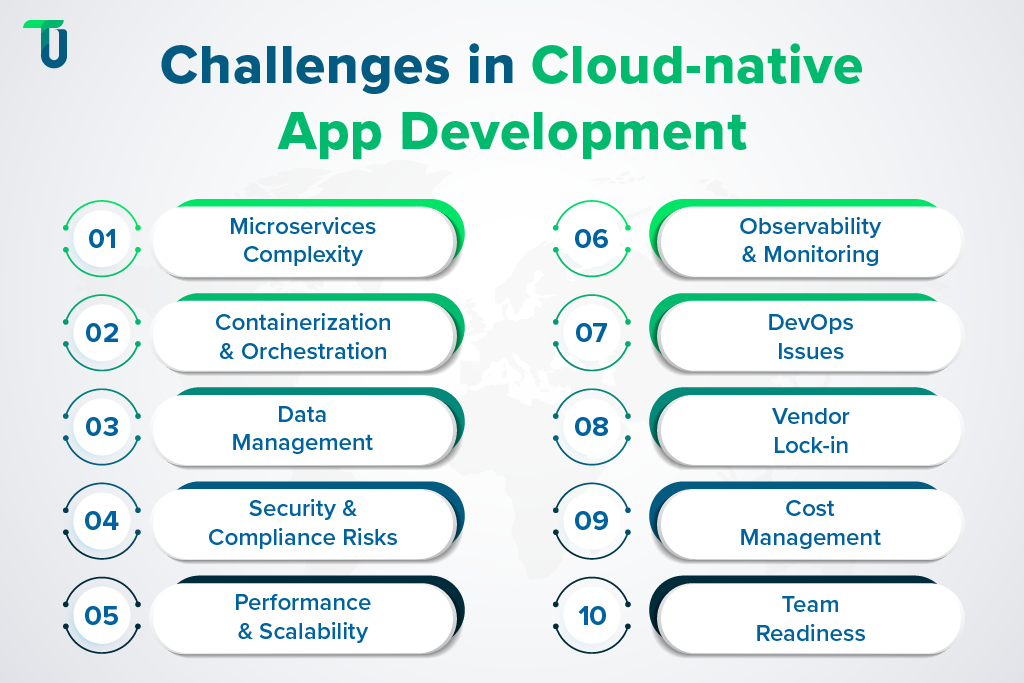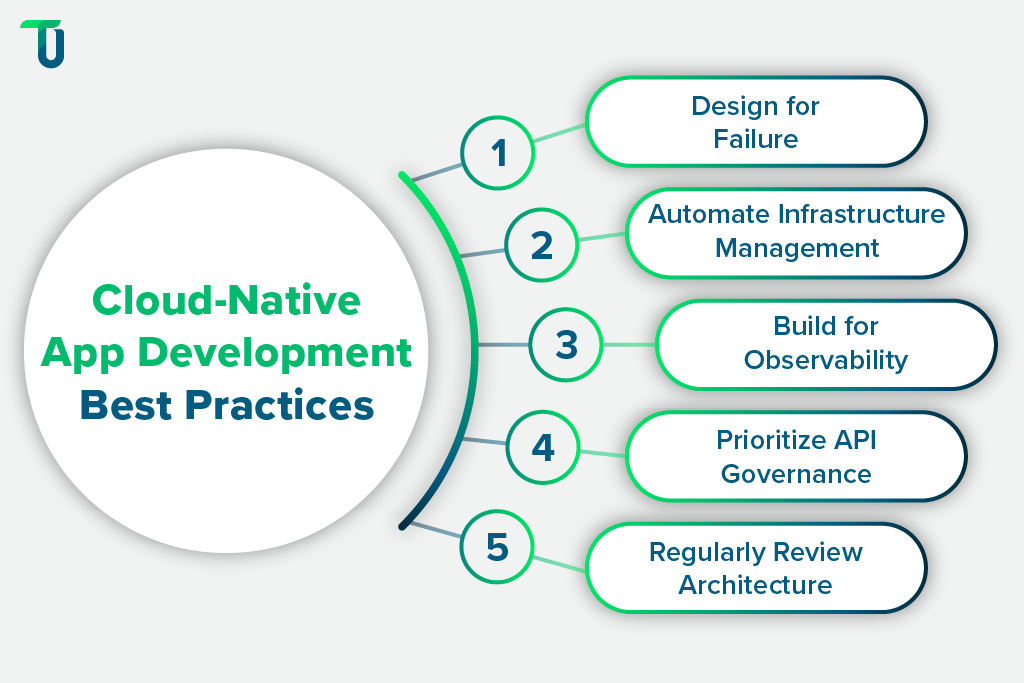Cloud-Native Application Development: Fundamentals and Challenges
Cloud native application development is an approach that uses cloud technologies from the ground up rather than adapting traditional applications for the cloud. Instead of building large monolithic systems, applications are divided into smaller, independent microservices that can be deployed and scaled separately. These services usually run in containers managed by orchestration tools such as Kubernetes.
To better understand the differences, explore our guide on Cloud-Native vs. Cloud-Based Applications.
Overcoming Challenges In Cloud-Native Application Development
From microservices complexity to rising costs, cloud native systems bring real hurdles. Many organizations seek enterprise cloud-native solutions and cloud-native consulting services to overcome these challenges effectively.
Here are the top 10 challenges in cloud native application development and practical solutions to overcome them.

1. Complexity of Microservices Architecture
As per the study, 65% of organizations report that managing microservices adds significant complexity to their IT environments. In cloud native application development, services must interact through APIs, which can lead to communication failures, debugging difficulties, and dependency management issues across multiple services.
To address this challenge:
- Define clear service boundaries using domain-driven design.
- Use API gateways for external requests and service meshes like Istio for internal traffic and observability.
- Keep APIs consistent and apply automated tests.
- Maintain proper documentation to simplify debugging and reduce confusion across teams.
2. Containerization and Orchestration
Containers help portability, but managing them at scale requires Kubernetes orchestration for cloud-native apps. In cloud native application development, configuring Kubernetes for networking, scaling, and storage requires expertise. Errors in orchestration can lead to wasted resources, downtime, or unstable application performance. That’s why many enterprises rely on Kubernetes consulting and cloud-native deployment services to streamline orchestration.
To address this challenge:
- Start with Docker on small projects, then adopt Kubernetes step by step.
- Use Infrastructure as Code tools like Terraform and Helm to automate configs.
- Set resource limits, namespaces, and liveness/readiness probes to avoid contention.
- Add monitoring and regular image scanning to catch issues before they reach production.
3. Managing Data in Distributed Systems
Data management is one of the hardest parts of cloud native application development, especially when building enterprise-grade systems that require custom cloud application development solutions. With applications running across multiple servers or regions, keeping data consistent and reducing latency is a challenge. Stateful data adds complexity in a system that favors stateless design.
To address this challenge:
- Choose databases built for distribution such as Cassandra, CockroachDB, or DynamoDB.
- Add caching layers like Redis to cut read latency.
- Use replication and partitioning to keep data available across regions.
- Adopt eventual consistency where strict immediate sync is not required.
Need Expert Cloud-Native Application Development?
Unlock scalability, security, and speed with TenUp’s cloud-native application development expertise. Get Started Today!
4. Security and Compliance Risks
Security in cloud-native application development is a major concern. In fact, misconfigurations are linked to 23% of cloud security incidents. Services, APIs, and containers can all become attack paths. Misconfigured permissions, weak access controls, and unencrypted communication make systems vulnerable.
To address this challenge:
- Apply zero-trust and least privilege for all services and users.
- Encrypt data in transit and at rest and enforce TLS everywhere.
- Use secrets managers like Vault or AWS Secrets Manager for credentials.
- Automate security and compliance checks in CI/CD and run regular audits.
5. Performance and Scalability
Applications in the cloud must scale with demand. Poor planning or misconfigured services can lead to wasted resources, high costs, or bottlenecks in performance. Cloud-native application development requires balancing scalability with reliability, efficiency, and security practices such as Zero-trust and compliance frameworks in cloud solutions. For deeper insights, explore our guide on best practices for scalable cloud-native architecture.
To address this challenge:
- Use autoscaling rules and tune thresholds based on real metrics.
- Put load balancers and CDNs in front of heavy traffic paths.
- Profile code and databases, then optimize hot paths and queries.
- Right-size instances and use caching to reduce repeated work.
Also Read: Designing Scalable Cloud Architecture: 10 Best Practices
6. Observability and Monitoring
In cloud native application development, monitoring is hard because logs, metrics, and traces are scattered across many services. Without observability, problems are hard to detect, making it difficult to respond quickly and prevent small issues from becoming outages.
To address this challenge:
- Enable structured logging, metrics, and distributed tracing from day one.
- Centralize logs and metrics in a single platform or dashboard.
- Create meaningful alerts with clear playbooks for response.
- Use sampling and retention policies to keep data manageable.
CI/CD Pipeline and DevOps Challenges
CI/CD is key in cloud native application development, but poorly designed pipelines create risks. Failed builds, broken deployments, or lack of rollback processes can disrupt users. Frequent updates without testing can introduce errors into production.
To address this challenge:
- Use GitOps or version control for infrastructure and deployments.
- Implement blue-green or canary releases to reduce deployment risk.
- Automate unit, integration, and end-to-end tests in the pipeline.
- Provide fast rollback paths and maintain reproducible build artifacts.
8. Vendor Lock-In
Once teams adopt proprietary tools or services, moving to another cloud becomes costly and complex. This lock-in limits flexibility, raises risks, and reduces freedom to choose the best option.
To address this challenge:
- Favor open standards, APIs, and portable tools where possible.
- Containerize workloads to make them easier to move between clouds.
- Abstract provider-specific services behind interfaces to reduce coupling.
- Test multi-cloud or hybrid setups with small pilots before committing.
9. Cost Management
The pay-as-you-go model in cloud native application development can easily lead to rising costs if not properly monitored. In fact, 78% of companies estimate they waste roughly 21–50% of their cloud spending each year on avoidable inefficiencies. Unused resources, scaling missteps, and inefficient configurations quickly add up.
To address this challenge:
- Implement cost monitoring, tagging, and budget alerts for all resources.
- Turn off nonproduction environments when idle and use spot or reserved instances.
- Right-size instances and tune autoscaling to match real demand.
- Review cost reports regularly and act on wasteful spending patterns.
Explore More: Proactive Measures to Prevent Overbilling in Cloud-based Services
10. Skill Gaps and Team Readiness
Cloud native application development requires new skills in microservices, containers, and DevOps.The fast pace of change in tools and platforms widens the skill gap, slowing down development and adoption. Many teams struggle because they lack hands-on expertise, leading them to explore cloud application development outsourcing as a faster way to adopt new technologies and fill talent gaps.
To address this challenge:
- Invest in practical training, certifications, and hands-on workshops.
- Start with small proof-of-concept projects to build confidence.
- Pair junior and senior engineers and document learnings for reuse.
- Consider external experts or managed services for specialized needs.
So these are the top challenges in cloud native application development. However, with the right strategy, tools, and expert guidance, businesses can overcome them. One of the ways could be applying microservices design patterns if this solution fits your business needs.
Best Practices to Improve Cloud Native Application Development
In addition to the solutions outlined above, there are proven ways to strengthen cloud native application development, especially when aligned with a cloud migration compliance strategy that ensures regulatory and security standards are met. Here are 5 best practices that help teams build reliable and future-ready systems.

1. Design for Failure
In cloud native application development, systems must expect hardware, network, or service failures. Building redundancy and recovery mechanisms ensures that one failing component does not crash the whole system. Regular chaos testing helps confirm that applications can handle disruptions without affecting users.
2. Automate Infrastructure Management
Manually managing servers or configurations leads to errors. Use Infrastructure as Code tools to automate provisioning and updates. This practice ensures consistent environments across development, testing, and production. Automation also speeds up deployments and reduces the risk of downtime during routine changes. Partnering with experts in end-to-end cloud application development and cloud security consulting for compliance ensures consistency across environments, faster deployments, and fewer errors.
3. Build for Observability from Start
Observability should not be an afterthought. Applications should generate useful logs, metrics, and traces from the beginning. Centralized dashboards and clear alerting rules allow teams to spot problems before they escalate. This proactive approach reduces troubleshooting time and improves reliability for end users.
TenUp’s Take: Cloud native application development benefits greatly from a culture of continuous learning. Encourage teams to experiment with new cloud tools in controlled environments. This mindset ensures systems stay current, efficient, and aligned with evolving business needs.
4. Prioritize API Governance
APIs are the backbone of cloud native application development. Clear versioning, proper documentation, and consistent design standards prevent integration issues between services. API governance also helps teams collaborate smoothly and ensures that external clients interact with applications in a stable and predictable way.
5. Regularly Review Architecture
Cloud environments change quickly, and an architecture that works today may become inefficient tomorrow. Regular design reviews help identify outdated patterns, security gaps, or performance bottlenecks, especially in complex environments such as where Kubernetes in multi-cloud orchestration plays a key role in maintaining efficiency. Partnering with a cloud-native application development company ensures your architecture stays scalable, secure, and future-ready. Reviewing architecture ensures applications continue to meet user demands while taking advantage of new cloud capabilities.
Partner with TenUp for Cloud Native Applications Development
While cloud-native applications help accelerate digital growth, they also bring challenges such as microservices complexity, data consistency, security, scalability, and cost control. As we explored in this blog, these challenges can be managed with the right practices—ranging from careful architecture design and strong governance to continuous improvement and, most importantly, the right partner like TenUp.
We help businesses overcome these hurdles with deep expertise in cloud-native development, cloud modernization, DevOps, and built-in cloud security and zero-trust architectures. As an ISO 27001-certified AWS Partner, we deliver solutions that are secure, scalable, and cost-efficient. Get in touch with our experts today.
Need Future-Ready Cloud-Native Application Development?
Overcome challenges, reduce risks, and drive innovation with TenUp’s proven cloud-native application development services.
Frequently asked questions
How much does it typically cost to hire cloud-native application development services for a mid-size enterprise?
For most mid-size enterprises, cloud-native development costs fall between $100,000 and $500,000, depending on project scope, integrations, and compliance needs. An MVP usually stays on the lower end, while complex multi-system builds can exceed this range.
Can I request a free cloud-native consulting assessment or pilot before committing to a full project?
Yes. Some cloud-native partners offer a free assessment or limited pilot to help you evaluate feasibility and vendor fit. These sessions let you test their expertise, validate your use case, and understand potential ROI, giving you confidence before moving into a full-scale engagement.
What should I expect from a cloud-native app development partner during the discovery phase?
They’ll align business goals with technical strategy, review current systems, outline architecture, timelines, and costs, and highlight risks. Expect a clear roadmap with cloud-native best practices to confirm feasibility and ROI before development.
How long does it take, on average, to complete an end-to-end cloud-native app development project?
Timelines range from 3–9 months, depending on complexity, integrations, and compliance needs. A basic MVP can launch in 8–12 weeks, while enterprise apps with advanced features or industry regulations often take closer to a year, delivered through iterative agile sprints.
How do I evaluate whether a cloud-native development vendor understands my industry-specific compliance requirements?
Look for a vendor with proven industry case studies, relevant certifications (HIPAA, SOC 2, GDPR, ISO 27001), and clear experience addressing your sector’s compliance challenges. Ask how they manage audits, data residency, shared responsibility, and security-by-design practices in their cloud-native architecture.
How do businesses calculate the total cost of ownership (TCO) for a cloud-native application?
Businesses calculate cloud-native TCO by summing upfront migration costs, ongoing infrastructure (compute, storage, networking), third-party tools, compliance, and support. They usually project over 3–5 years to compare with legacy systems, factoring in indirect costs like downtime and staffing, plus strategic benefits such as scalability and faster time-to-market.
How do businesses compare different cloud-native service providers for quality vs cost?
Businesses compare cloud-native providers by weighing performance (uptime, speed, scalability, security, compliance) against true costs (pricing models, hidden fees, data transfer, and support). Quality-driven vendors may cost more upfront but reduce long-term risks, downtime, and maintenance, making them more cost-effective over time.
What level of DevOps or CI/CD maturity should my business have before starting a cloud-native project?
You don’t need full DevOps maturity, but having version control, basic CI/CD pipelines, and some automation helps cloud-native adoption succeed. These practices reduce complexity and improve speed. If you’re at an early stage, you can still start small while gradually improving DevOps maturity alongside the project.

